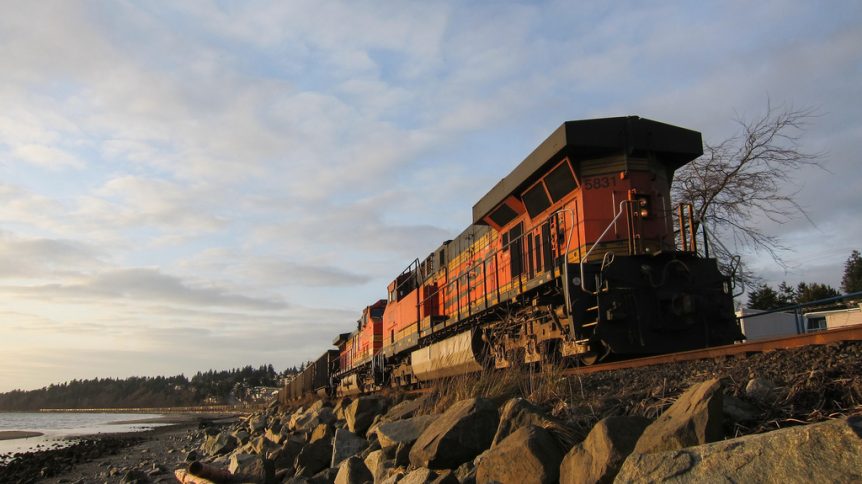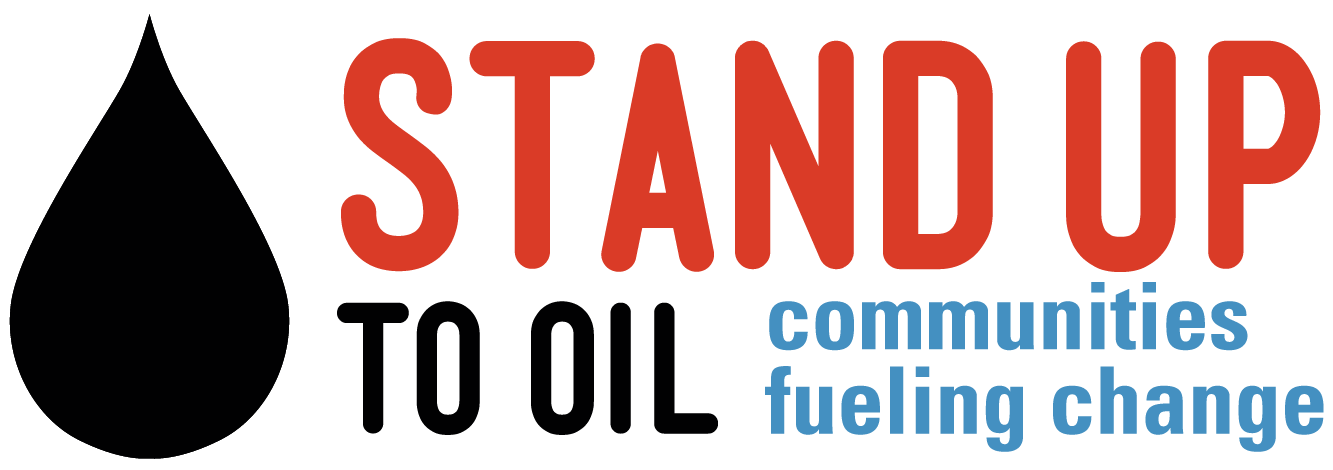By Ross Macfarlane
This blog series offers stories from the arc of the broad efforts in our region to stop coal exports off the West Coast. While the fight still continues, we have been successful so far. There is no one coal export campaign story because all who were involved brings a unique perspective and played varying roles. For example, we honor the stories from the courageous leadership of the Lummi Nation and other tribal leaders who convinced the US Army Corps of Engineers to deny the permits for the largest proposed coal terminal at Cherry Point, WA almost a year ago. We plan to publish more stories in this series and welcome submissions from other groups and friends who are involved in this amazing campaign.
You can read the first installment, Halting the Runaway Coal Export Train here, that sets the stage for the start of a multi-year effort to stopped what at the time seemed to be an unstoppable onslaught of proposed coal export terminal projects.
From the start, we faced a central challenge battling the perception that the proposed coal terminals were smart investments, backed by strong, well-funded corporations that would serve huge markets, hungry for their commodities. Most reporters and civic leaders, even highly sympathetic ones, took at face value the project boosters’ claims that eager investors were lined up ready to pour money into these projects, creating thousands of jobs. For communities still struggling to recover from the “Great Recession,” this “jobs vs environment” frame created an uphill struggle for our campaign. Project proponents banded together to form an “Astroturf” organization, The Alliance for Northwest Jobs and Exports, which single-mindedly pounded the theme that the terminals were going to bring billions of investment dollars into the region.
To be fair, when we first got involved, the coal industry’s narrative had every appearance of being true. Flipping this story and showing that in fact the proposed terminals were speculative bets on a short-lived bubble in coal markets became a key focus of our campaign and a major factor in our ultimate success.
Focusing on Coal Finances
A key “ah ha” moment for me occurred in the spring of 2011 when several leaders from Power Past Coal attended a conference on coal finance in New York City. Attorneys and activists from the Sierra Club, Greenpeace, and other global, national and local groups, many in coats and ties, mingled with top representatives from major banks, accounting and law firms, wearing blue jeans and casual clothes. The presentations and discussion focused on spreadsheets, not saving the earth; profit and loss statements, not polar bears. The overall message: the coal industry was at a tipping point, and was likely beginning a rapid slide toward collapse.
At the time, this message seemed counterintuitive, to say the least. The market values of the major US coal companies had soared to a post-recession peak in early 2011. The executives of all the major coal companies were all trumpeting a “coal supercycle,” fueled by exports to Asia, and were taking on massive amounts of debt to finalize huge acquisitions that they hoped would position them for dominance in global coal markets.
It soon became clear, though, that the US coal industry’s gamble on Asian markets was more of a “Hail Mary Pass” forced by its tough prospects at home, than an investment strategy based on a sober assessment of international markets. Local organizing efforts from around the country of national and local organizations, further propelled and coordinated through the Sierra Club’s remarkable “Beyond Coal” campaign had already virtually frozen construction of new coal-fired power plants in the US and was beginning to make significant progress in its goal of shutting down existing plants. In the summer of 2011, Mike Bloomberg announced a $50 million gift to the Beyond Coal campaign, supercharging these efforts and funding new efforts to understand the economics and financing for coal projects.
These citizen campaigns and new regulations on coal pollution played a significant role in shutting down coal plants, but the biggest driver was economics: natural gas, energy efficiency, and renewables were beginning to provide much cheaper alternatives for power generation making coal plants too expensive. Faced with unmistakable signs of declining markets in the US, the coal industry saw no choice except to get its product onto ships bound for Asia. Part of the industry’s cheerleading about a global “supercycle” was a desperate response to the growing evidence of domestic decline. Our role in the broader coal campaign, then, was to cut off this exit strategy and stop them at the coast—preventing the Powder River Basin coal miners from accessing their desired new markets for coal. And increasingly, we realized that developing a detailed knowledge of coal industry finances and economics was crucial to our efforts.
Finance and Investment Outreach – Exposing Execution Risks
Initially, much of our work on coal export finance and investment issues focused on educating investors on Wall Street about the significant risks and opposition facing these projects. Peabody, Arch, Cloud Peak, and other coal companies highlighted the port projects in investor presentations and quarterly earnings calls, providing extremely rosy forecasts to investors regarding the timelines for permitting and construction, as well the markets for their coal in Asia. Cloud Peak, for example, went “all in” on coal exports, explicitly building its growth strategy and investment thesis around the anticipated timing for Northwest ports.
Given the industry’s emphasis on exports, we realized it was important to educate the financial community on the “execution risks” relating to the projects and exposing the unreality of the project backers’ claims. We began cultivating relationships with stock analysts and financial press, set up calls and briefings, and prepared several reports focusing on these risks.
We found that, at least at the start, many Wall Street investors and analysts were unfamiliar with the permitting and legal issues and tended to assume that any opposition could be easily brushed aside and would at most result in minor delays for the projects. Providing factual information to key players in the financial community helped plant the seeds of doubts regarding the accuracy of the companies’ claims, the fanciful nature of their completion schedules, and the soundness of coal exports as an investment strategy.
Finance and Investment Outreach
Although our finance and investment work initially focused on educating Wall Street about the challenges and risks of betting on Northwest ports, we soon realized we also needed to educate regional officials, media, and opinion leaders on the changing reality of the global coal markets. Since the Northwest has never been a major coal producing or consuming region, most people here didn’t “know from coal” and accepted at face value industry assurances that these ports would be profitable centers serving growing markets. Our task was to share the growing concerns in the finance and investment world about the viability of coal exports, as well as the data showing an industry in collapse.
“The Emperor Has No Clothes”
Our first major success on the finance and investment front involved Ambre Energy, the lead driver of the Millennium project and also sole proponent of the proposed Morrow-Pacific project on the Oregon side of the Columbia River.
Environmentalists love to picture ourselves as “Davids” battling corporate “Goliaths.” It’s deep in our DNA. That mindset understandably dominated when we first decided to lie down in front of the coal juggernaut in the fall of 2010.
Perhaps that helps explain why, when Millennium’s owner Ambre Energy first appeared in our region, it was described both in the press and in some of our own materials as an “Australian coal giant.” This turned out to be what Ambre wanted us to think: a much better description of its aspirations than its real financial health.
The brilliant Clark Williams-Derry at the Sightline Institute deserves the credit for digging through financial reports and crunching the numbers to unearth a truer picture of Ambre’s financial health. Although a privately held company, Australian law requires significant public reporting on investments, income and other key financial metrics. Sightline completed a bomb-shell report, Ambre Energy – Caveat Investor, in February 2013, which showed that Ambre was a giant only in its pretensions. The report found:
“Ambre Energy barely qualifies as a coal company. More than half a decade after it was founded, the company remains little more than a high-risk start-up struggling to establish a toehold in the coal business—suggesting that Ambre’s vision of lucrative coal exports may stem not from savvy experience but from equal measures of hope and hype.”
The report showed Ambre had no real operating assets or experience, no significant financial backing, and no major assets in North America, other than the proposed terminals and part interest in several played-out coal mines that it had “purchased” from institutional investors for no cash and promises to assume the multi-million dollar reclamation liabilities after the mines closed. Sightline’s report cast doubt on Ambre’s ability to fund or raise the approximately $1 billion that would be needed to construct the terminals and meet these reclamation obligations.
Far from being a “giant,” the report showed Ambre to be a fly-by-night speculator that had hoped to pump up its prospects to make a quick killing in Australia’s stock market. Ambre had been painting an extremely optimistic picture of its prospects, telling investors it expected to be the largest exporter of thermal coal from North America to Asia. Ambre briefly tried to go public on the Australian stock market, valuing itself at over $200 million.
Sightline’s report pulled back the curtain and exposed this supposed “coal giant” as a pretender. Although Ambre reacted with outrage, The Australian (the financial paper of record Down Under), noted that the company did not dispute Sightline’s factual findings. The paper credited the think tank with a thorough “slating,” terming the report “well researched” and “damning.”
Sightline’s assessment was borne out by subsequent events, including a lawsuit between Ambre and Cloud Peak Energy over their joint ownership and operation of the Decker mine, where Cloud Peak alleged that Ambre’s export plans were highly speculative and the smaller company was “financially unstable.” Final proof came in late 2014 when Ambre was “sold” to its largest creditor, Resource Capital Funds, for enough money to pay off its other outstanding loans, leaving its original investors with nothing.
In the end, this Australian “coal giant” was exposed as a paper tiger, with no more ability to carry out its promises than Professor Harold Hill had to fill orders for the River City marching band. While these revelations only involved one company (albeit the prime mover behind two of the region’s proposed terminals), they also began to plant seeds of doubt about the financial viability of the entire coal industry and its export schemes.
Next: Coal’s Collapse
Ross Macfarlane was Senior Advisor at Climate Solutionsfrom 2007-2016, where he managed the business partnerships program and played a leadership role in the organization’s efforts to enact strong policy and move the NW Region away from fossil fuels. Prior to Climate Solutions, Ross had more than 25 year career in environmental law and public policy. Ross is a Fellow at Clean Energy Transition and a candidate for the Sierra Club national Board of Directors.


